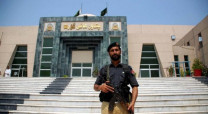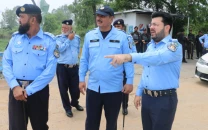Taliban on Twitter as Afghan rebels enter Internet age
The Taliban once banned all TV, music and cinema in Afghanistan, but now they are fighting their war via Twitter.

The extremists sent out their first tweet in English on May 12 claiming "enemy attacked in Khak-e-Safid", with a link to their website for more details about rebel fighters killing "at least 6 puppet police".
The move into the English language on Twitter is the latest sign that the Taliban are embracing modern technology in the propaganda battle that runs alongside the guerrilla war of ambushes, suicide bombings and mine explosions.
When they ruled Afghanistan between 1996 and 2001, almost all electronic products were outlawed as un-Islamic. Photographs of living things were illegal, and ownership of a video player could lead to a public lashing.
Today, they send out text messages and emails, release videos of attacks on US-led international troops, and run a website that evades repeated efforts to close it down.
"The Islamic Emirate of Afghanistan joined Twitter about six months ago," Taliban spokesman Zabiullah Mujahid told AFP, using the group's name from its time in power.
"We did it because we know Twitter is a popular social network in the West, and we want to make our voice heard. They used to hear only one-sided news about us from the invaders, but now they can know the reality."
Mujahid said that an official Taliban page on Facebook had been shut down by the company earlier this year, but supporters still host personal pages passing on news and information.
"We regard modern technology including the Internet as a blessing of God," he said, declining to explain the Taliban's change of attitude since they were toppled for sheltering al Qaeda after the 9/11 attacks.
The Taliban's Twitter feed @alemarahweb - a reference to Islamic statehood - sends out several messages every day, mostly in the Pashto language, and is followed by 4,200 people with the number growing rapidly since English was introduced.
The NATO-led coalition force in Afghanistan on Saturday used its own Twitter feed to post a response saying: "What's that? Taliban's tweeting in English? Lies are lies no matter the language."Bizarrely, the Taliban's Twitter account follows tweets sent out by a British soldiers' charity, as well as a carpet-weaving development programme and a site linked to Islamist militants in the Caucasus.
"The Taliban have now discovered the magical power of media technology and are widely using it in their favour and to attract new recruits," said Mohammad Zia Bomia, director of the Kabul-based Mahal News agency.
Its sophisticated website, currently at , has for years been posting information in Pashto, Dari, Arabic, Urdu and English - though many of the claimed attacks and death tolls are exaggerated or untrue.
Videos on the site show alleged coalition atrocities and footage of Taliban attacks accompanied by background music and gunfire.The Taliban also say they broadcast Internet radio programmes for two hours a day in some regions, despite low web access in the country.
The Afghan intelligence agency (NDS) concedes it has struggled to act against the Taliban's Internet presence, saying that the insurgents' technology experts are based outside the country.
"We have been trying to track them and prevent their propaganda activities as they are against our national interest and constitution," NDS spokesman Lutfullah Mashal said.
"Unfortunately they are almost all based outside Afghanistan soil," he said, in a veiled reference to Pakistan.
Despite the Taliban's use of technology, many Afghans warn that the group retains the strict anti-modern ideology that it displayed when ruling from Kabul. "They clearly express their goals of taking control again, putting an end to the present democratic system and imposing their version of Sharia law," Afghan media analyst Sediqullah Tawhidi said.
"Looking at these aims, one can be sure that they would behave the same as before and ban all signs of modernity and freedom if they return to power."



















COMMENTS
Comments are moderated and generally will be posted if they are on-topic and not abusive.
For more information, please see our Comments FAQ